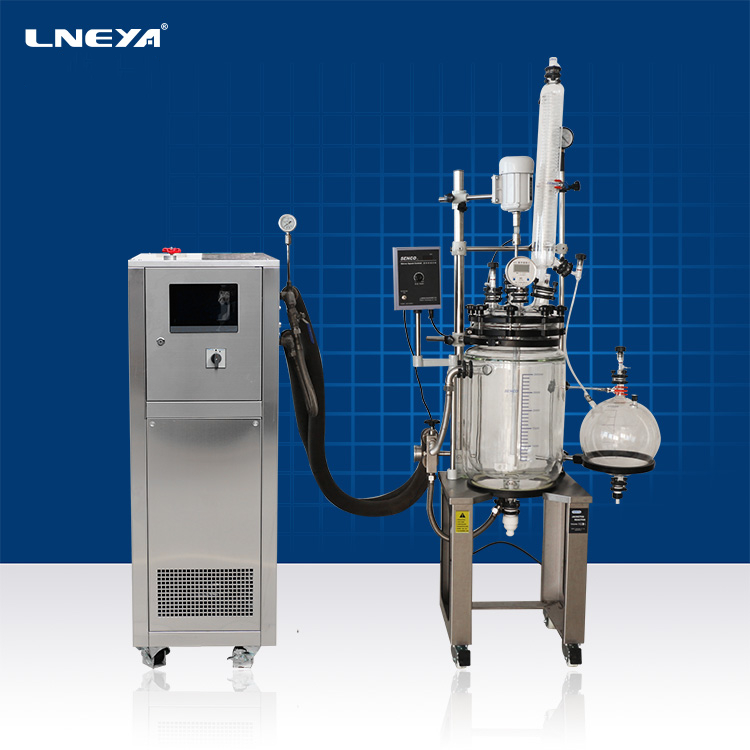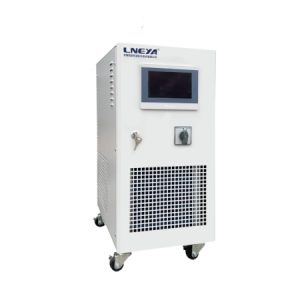Auswirkungen des Kühl- und Heizsystems auf den Glasreaktor
The glass reactor is compact in volume and clear in structure, and can be conveniently operated in series and parallel in a flexible manner, fully satisfying various process occasions; the reaction path does not have any metal contact, and the inlet and outlet ports use a special conical connector to facilitate the rapid connection of PTFE pipeline In addition, special import and export joints can also be customized according to specific needs. If you use LNEYA’s cooling and heating system equipment, you don’t have to worry about the size of the joint at all. We will match the joint according to your import and export flow.

The inner container of the double-layer glass reactor is equipped with reaction materials, and can be evacuated and speed-adjusted at the same time. The interlayer can introduce freezing liquid, water and high-temperature liquid to heat and cool the materials. It is used for synthesis of new materials in chemistry, fine chemicals and biopharmaceutical Wait for experiment, pilot and production. It can be combined with circulating water type multi-purpose vacuum pump, diaphragm vacuum pump, low temperature circulation (vacuum) pump, circulation cooler, constant temperature circulator, low temperature cooling liquid circulation pump, closed refrigeration heating circulation device, etc. to form a system device.
The temperature range of LNEYA cooling and heating system is -120 ℃ to 350 ℃, with high precision and intelligent temperature control. The ultra-high temperature cooling technology can directly cool down from the high temperature of 300 ℃. Since only the heat transfer medium in the expansion chamber is in contact with the oxygen in the air (the temperature of the expansion tank is between normal temperature and 60 ℃), the heat transfer medium can be reduced. High temperature heat medium will not evaporate at high temperature, and continuous control can be realized in the range of -80 ℃ to 190 ℃.
The glass reactor can be used in a large temperature range from high temperature (300℃) to low temperature (-80℃); it can work under normal pressure and vacuum conditions, and the vacuum degree can reach below 0.095MPa under static conditions. After the reaction of the interlayer cooling or heating solution, it can be completely eliminated without liquid accumulation. Choosing a good temperature control system equipment is inevitable for the reaction process and material testing.
Verwandte Empfehlungen
-
Chemischer Prozess ist untrennbar mit Temperaturkontrolle verbunden
1277Chemischer Prozess ist untrennbar mit Temperaturkontrolle verbunden
Details anzeigen -
Introduction To The Use Of Explosion-Proof Precision Chiller
1716Wuxi Lneya solves the problem of how to charge refrigerants in the absence of refrigeration. 1. Connect all kinds of equipment well, close the three valve when the vacuum pressure is down to 133.3Pa, remove the hose from the suction port of the va...
Details anzeigen -
Für welche Prozesse in Feinststoffbetrieben werden Kaltwassersätze benötigt?
1492Unternehmen, die sich mit der Herstellung von Feinstmaterialien befassen, benötigen häufig eine präzise Temperaturkontrolle während des Produktionsprozesses, um die Qualität des Produkts und die Stabilität des Produktionsprozesses zu gewährleisten. Kaltwassersätze spielen eine Schlüsselrolle in vielen Prozessen der...
Details anzeigen -
Kühlaggregat Wasserkühlung Kältemaschine
1295Das Kaltwasserkühlsystem ist eine effiziente Kühllösung, die Wärme durch zirkulierendes Kühlwasser abführt. Dieses System wird häufig in Industrie-, Labor- und Gewerbeumgebungen eingesetzt, insbesondere bei Anwendungen, die eine präzise...
Details anzeigen
 LNEYA Industriekühler Hersteller Lieferant
LNEYA Industriekühler Hersteller Lieferant











